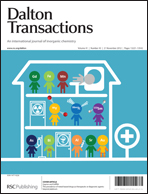Synthesis of [PdL(NH3)2](PF6)2 (L = 1,1′-di(alkyl)-3,3′-methylenediimidazolin-2,2′-diylidene) complexes and their reactivities towards N-donors†
Abstract
The reaction of neutral palladium complexes PdLBr2 (L = 1,1′-di(alkyl)-3,3′-methylenediimidazolin-2,2′-diylidene) with NH4PF6 in CH3CN afforded [PdL(NH3)2](PF6)2 (1–3, L1, alkyl = Me; L2, alkyl = Et; L3, alkyl = iso-Pr) and [PdL4(CH3CN)2](PF6)2 (4, alkyl = Mes). Treatment of [PdL(NH3)2](PF6)2 complexes with N-donors, 9-ethyl-3,6-diimidazolyl-carbazole (dicz), mercaptopyridine (HSPy), 3,5-dimethyl-1H-pyrazole (Hdmpz), and 1,2-dibenzoylhydrazine (H2dbhz) resulted in the substitution of NH3 forming dinuclear palladium complexes [PdL1(dicz)]2(PF6)4 (5), [PdL1(SPy)]2(PF6)2 (6), [PdL2(dmpz)]2(PF6)2 (7), [(PdL2)2(dbhz)] (8). Reaction of [PdL2(NH3)2](PF6)2 with hydrazine led to a mixture of [Pd(L2)2](PF6)2 (9) and [PdL2(NH2N![[double bond, length as m-dash]](https://www.rsc.org/images/entities/char_e001.gif) C(CH3)NHNH2)](PF6)2 (10). The NH2N
C(CH3)NHNH2)](PF6)2 (10). The NH2N![[double bond, length as m-dash]](https://www.rsc.org/images/entities/char_e001.gif) C(CH3)NHNH2 moiety was formed in situ by nucleophilic addition to CH3CN by two molecules of NH2NH2 and subsequent NH3 elimination. All of these complexes have been fully characterized by ESI-MS, NMR spectroscopy, and elemental analysis. The molecular structures of 1 and 5–10 were also studied by X-ray diffraction analysis.
C(CH3)NHNH2 moiety was formed in situ by nucleophilic addition to CH3CN by two molecules of NH2NH2 and subsequent NH3 elimination. All of these complexes have been fully characterized by ESI-MS, NMR spectroscopy, and elemental analysis. The molecular structures of 1 and 5–10 were also studied by X-ray diffraction analysis.
2 (L = 1,1′-di(alkyl)-3,3′-methylenediimidazolin-2,2′-diylidene) complexes and their reactivities towards N-donors](/en/Image/Get?imageInfo.ImageType=GA&imageInfo.ImageIdentifier.ManuscriptID=C2DT31739G&imageInfo.ImageIdentifier.Year=2012)

 Please wait while we load your content...
Please wait while we load your content...